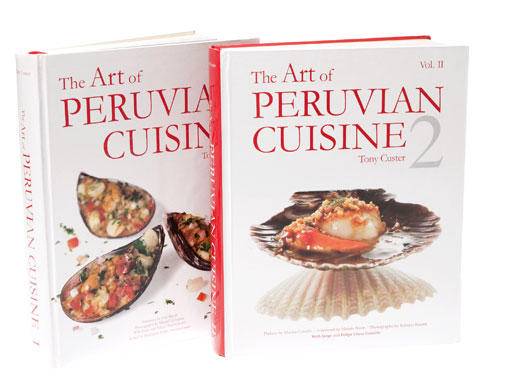Now that Peruvian cuisine has become a worldwide rage, it’s hard to believe there was ever a time when people didn’t know about Peru’s culinary treasures. In 2000, Peruvian businessman and president of Lima’s Fundación Custer Tony Custer helped introduce Peruvian cooking to the world with the publication of his best-selling The Art of Peruvian Cuisine.
At the time, Custer says, “when people thought of Peru, it was always Cuzco and Machu Picchu, but there’s a whole other world people miss out on. I wanted the world to see how rich and fascinating our food was; and there was no other book in English with quality photography.”
In 2011, Custer published a second volume that features Peruvian fusion recipes as well as traditional preparations. Now available in both Spanish and English, it has already sold more than 2,200 copies in Peru alone, making it a hit among local foodies.
But Custer was interested in more than just putting Peruvian cuisine on the map. One of his primary goals was to raise funds for Aprendemos Juntos (We Learn Together), a program started by his foundation that helps children with learning disabilities by sponsoring special classrooms with psychologists and behavioral therapists.
Custer’s first book, written in English, featured recipes for Peruvian classics like tiraditos, ceviches and anticucho, and has since sold over 85,000 copies globally in multiple printings, raising $1.4 million for Fundación Custer (all proceeds go to the foundation). “It exceeded our expectations beyond anything we ever dreamed,” says Custer.
While Custer loves cooking, his real passion is the foundation. Aprendemos Juntos, launched in 1996, was inspired by Custer’s experiences with family members who had learning disabilities.
The program targets first- and second-graders in 12 schools in Lima’s poorest neighborhoods. Students are tested in math, reading and writing; those who test in the bottom of their class are enrolled in the program. Special education teachers work with students twice weekly individually or in small groups in 50-minute sessions. The program also supports two-hour parent workshops to help promote learning at home.
Since the first foundation-sponsored classroom opened in 1998, it has helped over 7,000 students and 4,000 parents, and trained more than 100 teachers. Today the program works with 1,600 children and 50 teachers.
Next steps for the foundation include implementing a franchise model in other schools across the city. With two heavy, 200-plus-page volumes of Peruvian cuisine already out and selling well, there may not be much of the country’s culinary wonders to tap. For now, the foundation is identifying private-sector companies to help grow, fund and train teachers to expand the program. Let’s hope, too, that Custer finds a new trove of recipes.




